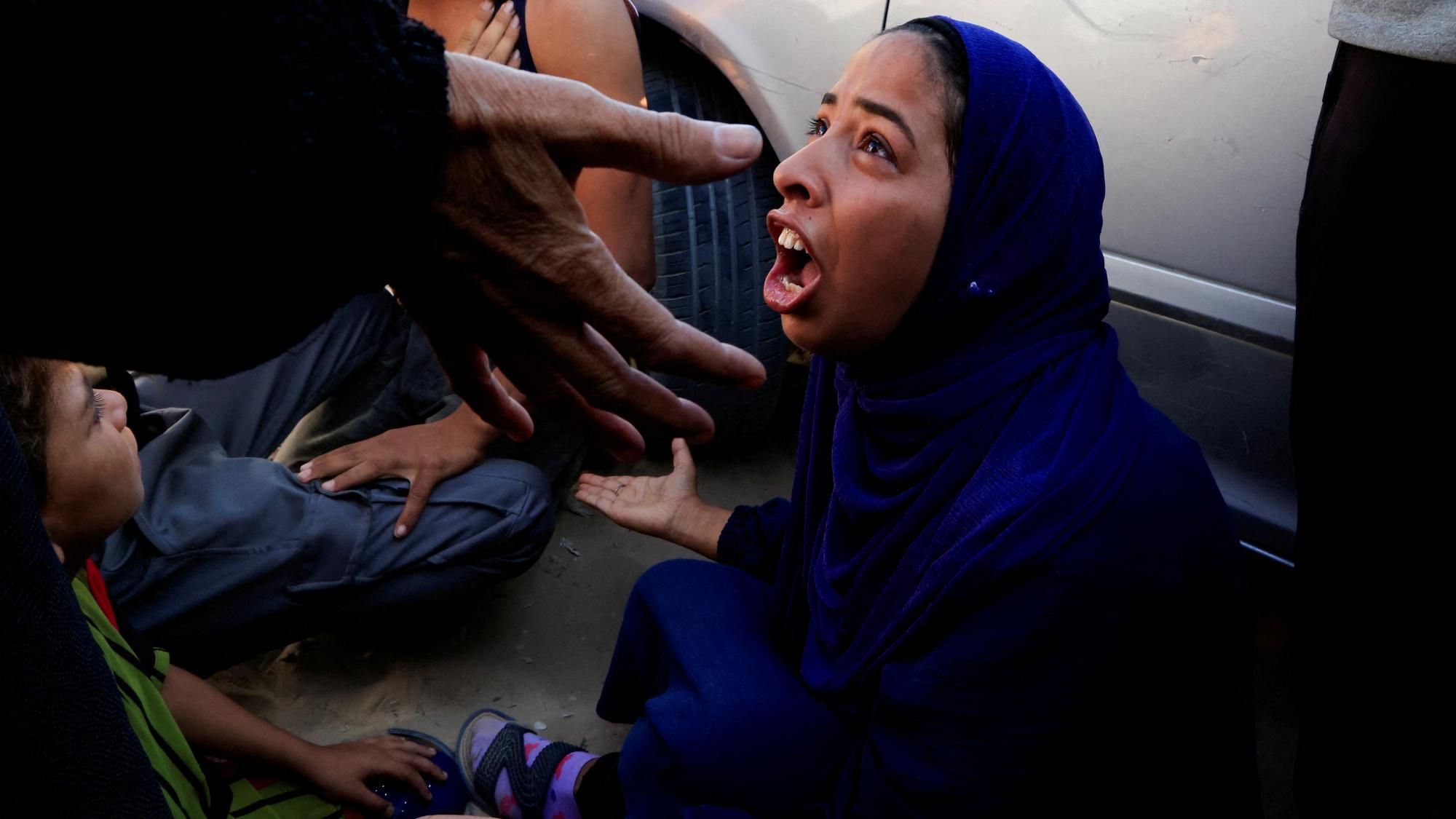Humanitarian Crisis in Gaza: A Critical Failure to Meet Sustainable Development Goals
Escalating Malnutrition in Direct Contravention of SDG 2 (Zero Hunger)
Recent reports from the Gaza Strip indicate a catastrophic failure to uphold Sustainable Development Goal 2, which aims to end hunger, achieve food security, improve nutrition, and promote sustainable agriculture. The humanitarian situation has deteriorated to the point of widespread starvation, with a significant loss of life directly attributable to malnutrition.
- Fatalities: The Hamas-run health ministry reported that at least 33 Palestinians, including 12 children, have died from malnutrition in a recent 48-hour period.
- UN Assessment: UN Secretary-General António Guterres stated that “malnutrition is soaring” and “starvation is knocking on every door,” highlighting a complete collapse of food security for the 2.1 million population.
- Vulnerable Groups: The World Food Programme (WFP) reported that 90,000 women and children are in urgent need of nutritional treatment, indicating a severe crisis that disproportionately affects the most vulnerable, a direct setback for SDG target 2.2 (ending all forms of malnutrition).
- Economic Barriers: Access to food is further crippled by hyperinflation, with a 1kg bag of flour reportedly costing over $100, making basic sustenance unattainable and pushing the population further from the goal of Zero Hunger.
Collapse of Health Services and Setbacks for SDG 3 (Good Health and Well-being)
The crisis represents a severe regression for Sustainable Development Goal 3, which seeks to ensure healthy lives and promote well-being for all at all ages. The healthcare system is unable to cope with the consequences of the famine, and medical facilities and personnel are themselves under direct threat.
- Documented Deaths: Medical professionals and humanitarian groups have documented numerous deaths from malnutrition, including those of a 13-year-old boy, a six-week-old infant, and several other children aged three months to four years. MedGlobal described the situation as a “deliberate and human-made disaster.”
- Systemic Strain: Hospitals like al-Shifa and al-Aqsa Martyrs are overwhelmed, lacking food for patients and essential medicines to treat malnutrition. A veteran employee at al-Shifa hospital noted, “Children are dying of hunger inside the hospital… I’ve never in my life have I seen someone die from starvation until now.”
- Compromised Operations: The World Health Organization (WHO) reported that its operations in Deir al-Balah have been compromised after its staff residence and main warehouse came under attack, directly impeding its ability to deliver on the mandate of SDG 3.
Obstruction of Humanitarian Aid and Violation of SDG 16 & 17
The ongoing conflict and restrictions on aid delivery demonstrate a profound failure to achieve SDG 16 (Peace, Justice and Strong Institutions) and SDG 17 (Partnerships for the Goals). The mechanisms for international cooperation and humanitarian assistance have broken down, with lethal consequences.
- Aid Discrepancy: While the UN states a minimum of 600 aid trucks are needed daily, an average of only 27 per day were permitted entry between May and July. Israel’s military body, Cogat, stated that 950 truckloads of aid were waiting inside Gaza for distribution, a claim the UN counters by citing ongoing hostilities, movement restrictions, and fuel shortages as critical impediments.
- Breakdown in Partnerships: The establishment of a new aid system by the Gaza Humanitarian Foundation (GHF), backed by Israel and the US, has been rejected by the UN and its partners. They cite safety concerns and violations of the humanitarian principles of impartiality and neutrality, showcasing a collapse in the collaborative spirit essential for SDG 17.
- Violence Against Civilians: The UN human rights office recorded the killing of 766 people near GHF aid sites and 288 along other aid convoy routes. This violence against civilians seeking life-saving assistance is a grave violation of international law and undermines the core principles of peace and justice enshrined in SDG 16. As stated by the UN Secretary-General, “This system is being denied the conditions to function, denied the space to deliver, denied the safety to save lives.”
SDGs Addressed in the Article
- SDG 2: Zero Hunger
- SDG 3: Good Health and Well-being
- SDG 16: Peace, Justice and Strong Institutions
Specific SDG Targets Identified
-
SDG 2: Zero Hunger
- Target 2.1: End hunger and ensure access to food. The article extensively details a severe food crisis, stating that “starvation is knocking on every door” and the “2.1 million population is facing grave shortages of basic supplies.” It also notes that “nearly one person in three was not eating for days,” directly addressing the lack of access to sufficient food.
- Target 2.2: End all forms of malnutrition. The article’s central theme is the deadly impact of malnutrition. It reports that “at least 33 Palestinians, including 12 children, have died as a result of malnutrition.” It further highlights that cases of “acutely malnourished, mainly children, had nearly tripled,” and “90,000 women and children [are] in urgent need of treatment,” showing a failure to meet this target.
-
SDG 3: Good Health and Well-being
- Target 3.2: End preventable deaths of newborns and children under 5. The article explicitly reports the deaths of children from malnutrition, which are preventable. Examples include a “six-week-old boy” and other children “aged between three months and four years old” dying from the lack of food and medicine.
- Target 3.d: Strengthen capacity for health risk management. The article describes a complete breakdown of the health system’s ability to manage the crisis. A hospital employee states, “Children are dying of hunger inside the hospital,” and the medical group MedGlobal confirms children died because there were “not enough medicines, including IV fluids and therapeutic formula, to revive them.” This points to a failure in managing a severe public health risk.
-
SDG 16: Peace, Justice and Strong Institutions
- Target 16.1: Significantly reduce all forms of violence and related death rates. The article provides stark figures on death rates from violence, stating, “At least 59,106 people have been killed in Gaza.” It also details violence related to aid distribution, with the UN recording “the killing of 766 people by the Israeli military in the vicinity of the GHF’s aid sites.”
- Target 16.a: Strengthen institutions to prevent violence. The article illustrates the collapse of humanitarian institutions meant to protect civilians. The UN Secretary-General states, “We are seeing the last gasp of a humanitarian system built on humanitarian principles. This system is being denied the conditions to function, denied the space to deliver, denied the safety to save lives.” The attacks on UN and WHO facilities and the inability to distribute aid safely show a failure to uphold and protect these institutions.
Indicators for Measuring Progress
-
For SDG 2 (Zero Hunger)
- Number of deaths from malnutrition: The article provides a direct indicator: “At least 33 Palestinians, including 12 children, have died as a result of malnutrition.”
- Prevalence of acute malnutrition: The report that “cases of acutely malnourished, mainly children, had nearly tripled” serves as a clear indicator of a worsening situation.
- Food prices: The article mentions that “a 1kg (2.2lb) bag of flour now cost over $100,” which is an indicator of food accessibility and market stability.
- Volume of humanitarian aid: The disparity between the “minimum of 600 aid lorries a day” needed and the “average of around 27 per day” that entered is a quantitative indicator of the food and supply shortage.
-
For SDG 3 (Good Health and Well-being)
- Child mortality figures: The specific mention of “12 children” dying from malnutrition, including a “six-week-old boy,” provides a direct indicator for Target 3.2.
- Availability of essential medicines: The statement that there are “not enough medicines, including IV fluids and therapeutic formula, to revive them” is a qualitative indicator of the lack of access to essential healthcare supplies.
-
For SDG 16 (Peace, Justice and Strong Institutions)
- Number of civilian deaths: The article provides a total death toll (“At least 59,106 people have been killed”) and specific deaths related to aid (“killing of 766 people… in the vicinity of the GHF’s aid sites”), which are direct indicators of violence.
- Attacks on humanitarian operations: The report that the WHO’s “staff residence and main warehouse came under attack” is an indicator of the lack of safety and the targeting of institutions designed to provide aid and protection.
Summary of SDGs, Targets, and Indicators
| SDGs | Targets | Indicators |
|---|---|---|
| SDG 2: Zero Hunger |
2.1: End hunger and ensure access to food.
2.2: End all forms of malnutrition. |
– Number of deaths from malnutrition (33 reported). – Tripling of acute malnutrition cases. – Price of flour at over $100 per kg. – Disparity between aid needed (600 trucks/day) and aid received (27 trucks/day). |
| SDG 3: Good Health and Well-being |
3.2: End preventable deaths of newborns and children under 5.
3.d: Strengthen capacity for health risk management. |
– Number of preventable child deaths (12 children, including a 6-week-old). – Lack of essential medicines, IV fluids, and therapeutic formula. |
| SDG 16: Peace, Justice and Strong Institutions |
16.1: Significantly reduce all forms of violence and related death rates.
16.a: Strengthen institutions to prevent violence. |
– Total number of people killed (59,106). – Number of people killed near aid sites (766). – Attacks on humanitarian infrastructure (WHO warehouse). – Denial of access and safety for humanitarian systems to function. |
Source: bbc.com







